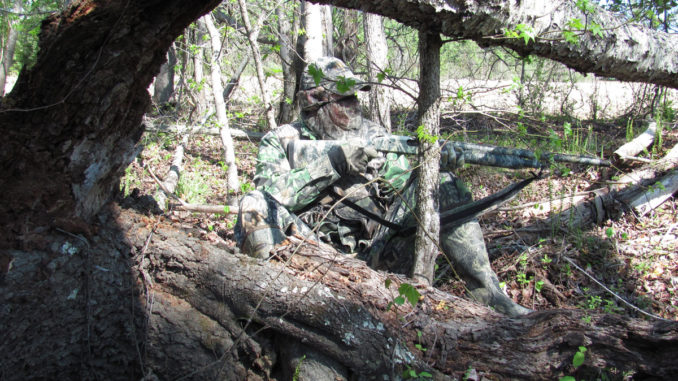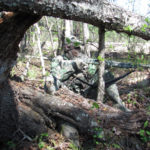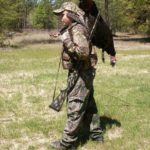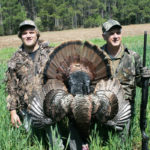
Quiet down, change calls or change positions to get the drop on a tom that stops out of range and won’t come any closer
Hunt turkeys long enough, and every hunter will learn that some gobblers are just more difficult to kill than others. A few years of experience usually enables hunters to call reasonably well and have a suitable sense of woodsmanship. Many take gobblers with reasonable regularity.
But there are always gobblers that readily answer good calling, in fact, they will sometimes cover long distances, only to stall out at about twice the range of your turkey gun. These gobblers really test a diehard hunter; they are the “hung-up” gobblers.
Some hunters simply give up on these hard cases and look for a willing and eager 2-year-old. But most turkey hunters have an inherent problem abandoning a tom that honors their hen calls with a gobble. When the gobbler figuratively toes a line on the ground that he will not cross, it strikes at the very fiber why turkey hunters hunt.
Jeremy Burnham has learned to cope with these birds better than most in 13 years of turkey hunting.
“On my first turkey hunt, I became head over heels addicted to the sport,” said Burnham, 35, who owns Atlantic Game & Tackle in Mount Pleasant. “I learned most of my early hunting tactics on my own and started hunting in the Francis Marion National Forest. Since then, I’ve learned a lot by experience and also by listening to turkey hunters discussing hung-up gobblers. I may put my own spin on some of the tactics I hear, because to beat a hung-up gobbler, I believe a hunter often must adapt on the fly.”
“My first-ever hunt was a perfect example for getting spoiled,” he said. “I scouted and researched the public land I planned to hunt, and while still at the truck, I hit a crow call and a bird gobbled. I moved quickly toward him and set up. Using a glass friction call, I killed him at 15 feet. The gobbler came in, was strutting and drumming ,and I was head over heels hooked on the sport.”
Burnham thought the sport was easy, but then he went a while before killing his second bird.
“A turkey hunter needs to be humble or get humbled by hung-up gobblers,” he said. “I was schooled about hung-up gobblers the hard way. I have also learned that while they can be much more difficult, the rewards are greater when successful. Don’t back away from a gobbler that stops short; learn how to kill him anyway.”
Burnham said the keys are versatility and adaptability.
“A successful turkey hunter must be versatile,” Burnham said. “Versatility with various calls to sound like different hens is often a key to getting these birds to make a move. For some reason, I have a gag reflex with a diaphragm call, but I adapted by becoming confident with a number of other calls. I use friction calls, including slate, glass and crystal pot calls, as well as various box calls among others.
I’ve also adapted by learning to use a true slate call one-handed. I place it on the ground on my side opposite of the gobbler and can continue to make calls with the call lying on the ground. When the gobbler approaches, I keep my hand hidden and ease it up into shooting position, shielded by my body.”
Burnham said there is no foolproof tactic for a hung-up gobbler, nor do all the tactics combined equal 100-percent success.
“Use tactics that put the odds in your favor and allow you to win some of these confrontations,” he said.
Burnham said a favored tactic he successfully employs on a hung-up gobbler is to play a mind game.
“A gobbling bird that approaches but hangs up had interest in the hen sounds, so I play off his interest,” he said. “There could be a barrier such as creek, pond, fence or other obstacle, but often it’s not. If you know the woods, you’ll know about these barriers. In nature, the hen is supposed to go to the gobbler, so it may just be his attitude of only coming so far and leaving the rest to the hen.
“My first strategy is to make very realistic contented, subtle calls like clucks and purrs,” he said. “I do not use aggressive calling at first when the gobbler sounds like he’s alone. If the gobbler hears sounds like the hen is content without him, I think a jealously or curiosity factor comes into play. It’s like high-school days with teenagers. We’ve all experienced the playing ‘hard-to-get’ routine, and it may work on a gobbler just like a teenager. This work great on 2-year-old birds, but even though older gobblers are more wary, this can be the downfall of any gobbler. I’ve taken old, long-spurred gobblers with this tactic.”
Burnham said that when a gobbler just hangs up and won’t budge, he will make a move. “Plan the move carefully, because he may move a little; they often walk back and forth when hung up,” he said. “Also, they hang up in fields a lot and can literally go in any direction. There could be another bird with him, perhaps a jake. If you approach front-on, you can easily bump a bird you didn’t know was there, and that ends the game. So I circle and get on his level on similar terrain. He’s hung up there for a reason. If he’s above or below me, I get on his level. If he’s at the edge of a swamp, I set up there, anything similar to the area he’s hung-up in, and then and call with soft and contented calls. Often that’s all it takes.”
Burnham said a turkeys comfort zone is often the undoing of a hung-up gobbler.
“I scout to find gobblers’ comfort zones as well as roosting and feeding areas,’ he said. “A comfort zone is simply a place they like. If you’ve seen strut marks on previous hunts or seen birds strutting, feeding or even loafing mid-day; make a mental note of these sites. That can be a starting spot for calling in many instances. But if you strike a gobbler elsewhere, and he hangs up and doesn’t respond to other techniques, I’ll move to the closest comfort zone to him.
“Doing this, I am in a spot turkeys have demonstrated they like to frequent,” he said. “It’s easier to get a gobbler to break and approach those areas. Also, if you are not totally familiar with the land, there could be a physical barrier that causes the bird to stop. Even the best callers seldom defeat this without making a move. If you get to a comfort zone and use clucks and purrs, your odds improve. Also, his route to that area may not be obstructed.”
Another hunter skilled and schooled in hung-up gobbler is 46-year-old Johnathan Alford of Hanahan, who said strategy is paramount to his success on these gobblers.
“I often call for friends, and sometimes I may not know the terrain if it’s my first trip,” Alford said. “When a bird hangs up in that situation, I’ll give him time to slip in silently, but if he doesn’t show, I’ll make a big move in case there is a physical barrier. I try to change my calling location by 90 degrees or more in his direction as I start a circle around him. I’ll use a totally different call and sound like a totally different hen. I move quickly so I can make my first call to the location where he originally hung-up. If the gobbler moves before I make my first call, that usually requires another movement strategy.”
Alford agrees with Burnham that low, subtle calls are best in this situation and he has a great “tool” for sounding realistic.
“I like the contented feeding or simple communication hen sounds for my calls, but I use a real turkey foot from a gobbler I’ve taken previously to make lifelike scratches in the leaves,” Alford said. “I spare no effort in being lifelike when tackling a hung-up gobbler, and using the turkey foot, I scratch the same pattern as they normally scratch in the woods. A gobbler can hear the scratching a long distance, and I believe this added realism has helped me take older birds that may not have come to moving and calling alone.”
Alford said that paying big attention to small details has helped in many instance on hung-up gobblers.
“It’s important to listen to a bird gobbling and approaching in case he does hang up,” Alford said. “I get his direction of movement so I know his walking pattern. If I know the land, I’ll know if there’s a physical barrier. I also know that by tracking his course until he stops, I know there were no obstructions up to that point. I have bee successful with a 180-degree move on some gobblers. Some hunters feel a gobbler won’t go back the way he approached, but by sounding like a totally different hen, it does sometimes work, especially if there is a physical barrier. It may mean I have to ford a small creek, circle a pond or get around a dense thicket, but that’s just part of turkey hunting.
“I use terrain to my advantage,” Alford said. “Last year, I had a gobbler strutting in a field, and he would gobble but not approach. I was a long way off and needed to cut the distance. A ditch ran alongside the field, so I hunkered down and eased down that ditch and finally got close enough to the gobbler to make some calls. Apparently, I was close enough, because he started walking straight to me, in and out of strut, and within a few minutes he was in range.”
Alford said that when things do not work out with a gobbler at the end of a hunt; you can still get crucial information.
“Sometimes, it’s the next day I kill a gobbler that hung up on me,” he said. “I track his movement to where he hangs up, and if he doesn’t approach, but I can still make him gobble, I track his exit strategy. Now I know where he’s willing to walk, and the next day, I’ll set up on that route, and often, the gobbler will come in without hanging up. Even if you fail to kill the bird the first day, learn everything you can from what happened and apply it as a positive move the next time you hunt that area — but the sooner the better.
A totally different tactic comes from Steve Cobb, a 52-year-old Union resident who is a seven-time state turkey calling champion and has been a member of the Hunter Specialties pro staff for 18 years.
“There a number of tactics that work, but a favorite of mine is one that can get real exciting,” Cobb said. “If a bird hangs up, and it’s not a physical barrier, I do something a lot of hunters won’t, and that’s to get real aggressive. I’ll typically use a mouth call and hit him with everything I’ve got.
“A hung-up gobbler will usually still gobble, and if I can get him fired up to where he triple-gobbles, I immediately shut the calling off,” Cobb said. “I sit quietly and wait, and more times than not, he’ll eventually hit one gobble. When he does, get the finger near the safety, because he’s coming. Sometimes, he’ll hit another gobbler about halfway in, and usually pretty soon I’m looking at him. They just can’t stand not coming in for a look after getting so fired up.”
Burnham said the list of possible successful scenarios on hung-up gobblers continues as far as your imagination takes it.
“The keys to remember are comfort, realism, patience and at times, just being sneaky,” he said. “As long as the hung-up gobbler doesn’t suspect it’s a non-turkey he’s dealing with, you’re still in the game.
“Hung-up gobblers are part of the sport, and these gobblers haunt hunters every spring,” he said. “I believe successfully hunting these gobblers can be the defining hunts of the season. Being able to finish off these stubborn gobblers is a legacy every turkey hunter would like to leave.”







Be the first to comment